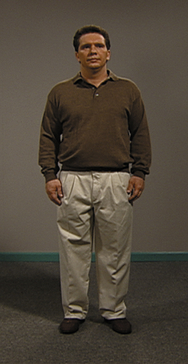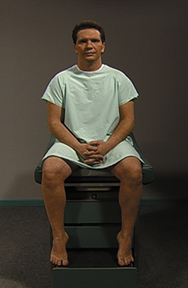• Signs of distress or disease • Relationship with others in room • Degree of interest in what is happening in room • Manner with which you are met • Moistness of palm when you shake hands • Eyes—luster and expression of emotion • Speech pattern, disorders, foreign language • Difficulty hearing, assistive devices • Vision problems, assistive devices • Orientation, mental alertness Stand in front of patient seated on examining table. • Inspect skin characteristics. • Inspect symmetry and external characteristics of eyes and ears. • Inspect configuration of skull. • Inspect and palpate scalp and hair for texture, distribution, and quantity of hair. • Palpate temporomandibular joint while patient opens and closes mouth. • Palpate sinus regions; if tender, transilluminate them (may be helpful, but sensitivity and specificity are uncertain when considered separate from other findings). • Inspect ability to clench teeth, squeeze eyes tightly shut, wrinkle forehead, smile, stick out tongue, and puff out cheeks (CN V, VII). • Test sensation using light touch on forehead, cheeks, chin (CN V). • Inspect eyelids, eyelashes, palpebral folds. • Determine alignment of eyebrows. • Inspect sclerae, conjunctivae, irides. • Test pupillary response to light and accommodation. • Perform cover-uncover test and corneal light reflex. • Test extraocular eye movements (CN III, IV, VI). • Assess visual fields (CN II). • Ophthalmoscopic examination: • Inspect lips, buccal mucosa, gums, hard and soft palates, floor of mouth for color and surface characteristics. • Inspect oropharynx: note anteroposterior pillars, uvula, tonsils, posterior pharynx, mouth odor. • Inspect teeth for color, number, surface characteristics. • Inspect tongue for color, characteristics, symmetry, movement (CN XII). • Test gag reflex and “ah” reflex (CN IX, X). • Assess sense of taste test when clinically indicated (CN VII, IX). • Inspect for symmetry and smoothness of neck and thyroid. • Inspect for jugular venous distention (also when patient is supine). • Perform active and passive range of motion; test resistance against examiner’s hand. • Test strength of shoulder shrug (CN IX). • Palpate carotid pulses. Be sure to palpate one side at a time (also when patient is supine). • Palpate lymph nodes—preauricular and postauricular, occipital, tonsillar, submental, submandibular, superficial cervical chain, posterior cervical, deep cervical, supraclavicular.
Head-to-Toe Examination
Adult
Components of the Examination
General Inspection

Patient Seated, Wearing Gown

Head and Face
Eyes
Mouth and Pharynx
Neck
![]()
Stay updated, free articles. Join our Telegram channel

Full access? Get Clinical Tree


Head-to-Toe Examination: Adult
Get Clinical Tree app for offline access
